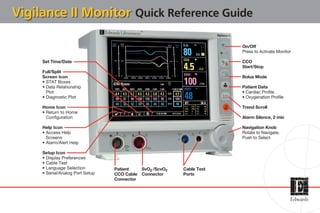
ar07822-vigilance_ii_monitor_sellsheet_6x9alr
- 1. Vigilance II Monitor Quick Reference Guide Set Time/Date Full/Split Screen Icon • STAT Boxes • Data Relationship Plot • Diagnostic Plot Home Icon • Return to Home Configuration Help Icon • Access Help Screens • Alarm/Alert Help Setup Icon • Display Preferences • Cable Test • Language Selection • Serial/Analog Port Setup Patient CCO Cable Connector SvO2 /ScvO2 Connector Cable Test Ports On/Off Press to Activate Monitor CCO Start/Stop Bolus Mode Patient Data • Cardiac Profile • Oxygenation Profile Trend Scroll Alarm Silence, 2 min Navigation Knob Rotate to Navigate, Push to Select
- 2. See Vigilance II monitor operator’s manual for detailed instructions. For professional use. CAUTION: Federal (United States) law restricts this device to sale by or on the order of a physician. See instructions for use for full prescribing information, including indications, contraindications, warnings, precautions and adverse events. Edwards Lifesciences devices placed on the European market meeting the essential requirements referred to in Article 3 of the Medical Device Directive 93/42/EEC bear the CE marking of conformity. Edwards, Edwards Lifesciences, the stylized E logo, Swan-Ganz, Vigilance, and Vigilance II are trademarks of Edwards Lifesciences Corporation. © 2012 Edwards Lifesciences Corporation. All rights reserved. AR07822 Vigilance II Monitor Quick Reference Guide Oximetry Setup and Calibration In-Vitro Calibration 1. Connect the optical module to the SvO2/ScvO2 color-coded connector on the front of the monitor. Connect catheter to the optical module with the “Top” side up. Allow 20 minutes for the module to warm up. 2. Use the navigation knob to highlight the SvO2/ ScvO2 large parameter frame. Press knob to display calibration menu. Highlight In-Vitro Calibration. Press knob to select. 3. Highlight HGB. Press knob to select. Enter hospital lab values by turning the knob. Press knob to confirm setting. 4. Turn knob to highlight Calibrate. Press to select. Upon successful completion of calibration, insert catheter in patient. 5. Highlight Start. Press knob to select. In-Vivo Calibration 1. Use the navigation knob to highlight the SvO2/ ScvO2 large parameter frame. Press knob to display calibration menu. 2. Highlight In-Vivo Calibration. Press knob to select. 3. After 25 seconds Draw is highlighted. Press knob just prior to drawing waste and lab samples. 4. Use knob to enter oximetry and HGB or Hct values. 5. Highlight Calibrate. Press knob to select. To Transport 1. The Swan-Ganz catheter should remain connected to the optical module during transport. Unplug the optical module cable from the Vigilance II monitor. Transport the patient. 2. If reconnecting to a different Vigilance II monitor, press the patient data button, select New Patient, select Yes, and Yes again. 3. Reconnect the optical module cable to the Vigilance II monitor. 4. Highlight and select oximetry large parameter frame. Select Recall OM Data. The calibration data stored in the optical module will be displayed. 5. If stored data is less than 24 hours old a Yes or No option will be displayed. Select Yes to begin oximetry monitoring. If No is selected, In-Vivo calibration will be necessary. Continuous Cardiac Output 1. Connect the patient CCO cable to the color- coded connector on the front panel. 2. If CEDV is required, connect the ECG interface cable from the bedside monitor to the ECG connector on the Vigilance II monitor rear panel. 3. Connect an Edwards advanced technology Swan-Ganz catheter to the patient cable per catheter instructions. 4. Press CO Start/Stop button to begin continuous cardiac output monitoring. If CEDV monitoring is required: • Highlight one of the large parameter frames. Press knob to display menu. • Highlight and select Parameter, then EDV. Highlight Return. Push knob to select. Activating STAT Boxes 1. Highlight the Full/Split Screen icon. Press knob to select. 2. Highlight the lower frame of the split screen. Press knob to select. 3. Highlight STAT Boxes. Press knob to select. Signal Quality Signal Quality May be Compromised by: • Pulsatility • Signal intensity (e.g., kinking of catheter, blood clot, hemodilution) • Intermittent wall contact by the catheter Signal Quality May be Improved by: • Try to aspirate distal lumen; if able to aspirate, flush lumen with extreme caution • Check catheter for kinking and recalibrate; replace catheter if required and recalibrate • Reposition catheter and if SQI 2, recalibrate monitor by performing in-vivo calibration • Attempt to distance electrocautery equipment and cables from the Vigilance monitor • Plug the power cord into separate AC circuits if possible • Update entered hemoglobin and hematocrit values when there is a physiologic change of 6% or greater in hematocrits or of 1.8 g/dl (1.1 mmol/L) or greater in hemoglobin Edwards Lifesciences Irvine, USA I Nyon, Switzerland I Tokyo, Japan I Singapore, Singapore I São Paulo, Brazil edwards.com